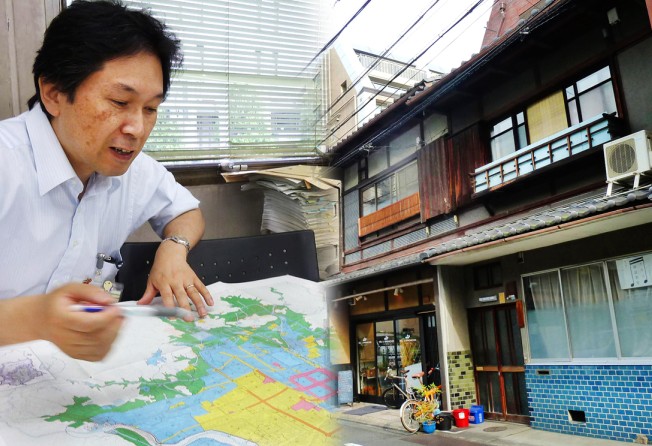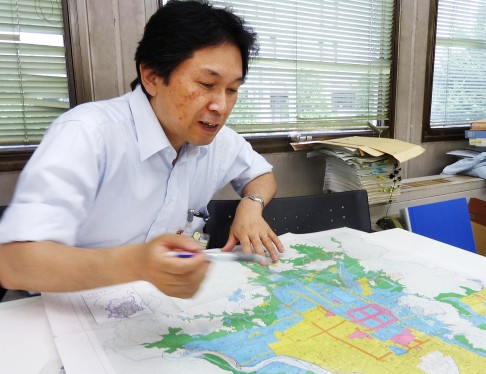
Lessons from Kyoto on preserving Hong Kong's architectural heritage
As Hong Kong seeks input on how to protect its heritage, the Japanese city's strict building codes and preservationist mindset may be a model

Walking through the streets of Kyoto today, you can still get a taste of the Japanese capital of Heian-kyo built 1,220 years ago.
The grid-patterned streets in central areas modelled after the Tang dynasty (618-907) Chinese capital of Chang'an mingle with tens of thousands of traditional wooden townhouses to create a low skyline unlike those of most major cities of the world.

It could almost be an object lesson for Hong Kong as it prepares to enact a new policy on preserving what is left of the city's heritage buildings.
But Kazuhiro Yamamoto, chief of Kyoto city government's landscape policy section, doubts whether his city's law on architectural heritage - one of the most stringent in the world - could work anywhere else, even in Japan.
"Most of our citizens have a strong sense of preserving the historic landscape, and that's why it is easier for us to secure people's support when implementing these restrictions," Yamamoto told the South China Morning Post via an interpreter.
The city has found its own way of preserving its rich aesthetic heritage. Beyond the conservation of some 200 centuries-old temples and shrines as individual buildings, the concept of conservation is integrated with landscaping and planning policies.

In its request for comment, the board noted that conservation advocates had been increasingly calling for a "point-line-plane" approach to conservation. That method looks at individual buildings as points, buildings along a street as lines and collections of streets as planes.
Some have called for whole cityscapes to be preserved as opposed to the current policy that targets individual buildings.
The Kyoto experience offers a case study on preserving cityscapes. "Our landscape policy in the past was a bit imbalanced," Yamamoto said, citing the erection of tall buildings alongside traditional wooden buildings known as kyo-machiya.
"Many citizens were saddened by these scenes. So we revised our policy in 2007."
Like many cities, Kyoto has struggled through conflicts between heritage conservation and urban development.
The opening of the 131-metre Kyoto Tower in 1964, and the announcement of the Kyoto Station Building project with a big department store and a hotel in 1994, were both criticised for destroying the city's historic look.
With lessons learned, legal amendments seven years ago lowered the height caps on new buildings across different zones, with the highest limit reduced from 45 metres to 31.
Four types of "landscape districts" were drawn up in accordance with their cultural and aesthetic importance, with different restrictions imposed on new buildings in respective areas.
On top of absolute height restrictions, the city also restricts building heights in certain areas to prevent buildings from blocking the public's view of important cultural features.
Views of the five giant bonfires lit on mountains in August for the Gozan No Okuribi festival, for example, are assured under the rule.
"You can only find this law in Kyoto," the official said.
Even colours are regulated. By next month, outdoor advertisements with colours and designs which the authorities deem incompatible with the historic aesthetics of their surroundings must be replaced, under a policy announced in 2006.
With strict building codes in the northern part where heritage buildings are concentrated, the city finds space for development by earmarking other sites with lenient rules, Yamamoto said.
South of the historic districts, two sites free of height restrictions with an approximate total area of 100 hectares are designated for commercial development. The sites house the headquarters of multinational companies such as Kyocera, a New York-listed electronics brand, and video game giant Nintendo.
"Limits in the north have to be strict," Yamamoto said. "The south is for development and the north is for history and culture conservation."
Kyoto citizens in recent years have become increasingly aware of the change in the city landscape due to a gradual loss of kyo-machiya, which can be traced back to the 1960s when an economic boom made construction of concrete houses popular.
A survey by the city government five years ago put the number of kyo-machiya at 48,000. Yamamoto said the number was estimated to be declining at an annual rate of 1.8 per cent. The homes are often sold to developers to build new houses.
To encourage the preservation of kyo-machiya and other privately owned heritage buildings, the Kyoto city government subsidises their maintenance.
Depending on the zoning of the buildings, owners may apply for funding equivalent to half, two-thirds or four-fifths of the maintenance costs with caps ranging from three million to 10 million yen (HK$760,853).
In Hong Kong, private owners of graded historic buildings may apply for maintenance grants of up to HK$1 million.
But Kyoto does not buy private buildings in order to preserve them. That approach failed to save the famed Ho Tung Gardens in Hong Kong last year, after the building's owner and the city government couldn't agree on terms for a sale.
Professor Ho Puay-peng, a board member and director of the Centre for Architectural Heritage Research at Chinese University of Hong Kong, said he was not too concerned with the introduction of the "point-line-plane" approach in Hong Kong because "the time to do it has already passed".
"Every time I go to Kowloon City, I am saddened because high-rise pencil towers are destroying the area," he said.
But not all historic Hong Kong neighbourhoods are beyond preservation, Ho says. A group of stilt houses in Tai O, the "rhythm" of slopes, the smaller independent shops and the design of narrow streets in Tai Hang, for example, could still preserve the "historical ambience" in the areas.